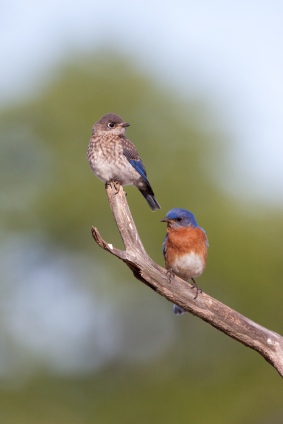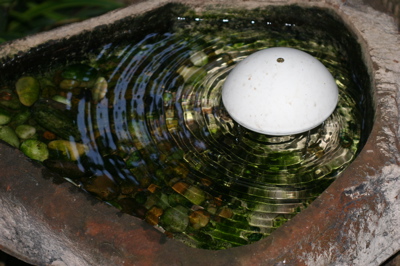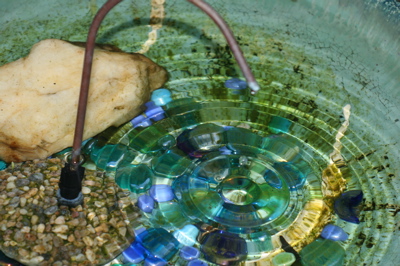-
bluebird houses alone may not cut it
 The “Bluebird of Happiness” is one special little songbird that many backyard birders try to entice to their yards. The task can sometimes prove fruitless without the right combination of elements.
The “Bluebird of Happiness” is one special little songbird that many backyard birders try to entice to their yards. The task can sometimes prove fruitless without the right combination of elements.First there’s shelter, in the form of nest boxes, or bluebird houses. But don’t expect success with just slapping up a house. Proportionally-sized for Eastern and Western Bluebirds, these houses have certain features required for a successful brood. A predator guard is a plus, and having a duplicate bluebird house nearby may help with the fierce competition by non-native birds like the House Sparrow. Placement is important too, as Bluebirds prefer their nest boxes in open spaces. Shelter also involves cover, protection from predators in the form of mature trees and shrubs.
Now bluebird houses can run the gamut from your basic nest box (which serv
 es the purpose well) to detailed copper roof houses, and decorative artisan’s works. The main thing is proportion and size, and drainage. Some bluebird houses will have a raised screen on the floor to prevent parasites, others have built in predator guards, and some have clear acrylic viewing windows to check the progress of nestlings without disturbing them. Some may have all these features, while others may have none of them. You usually get what you pay for in this instance, but again, a basic nest box will
es the purpose well) to detailed copper roof houses, and decorative artisan’s works. The main thing is proportion and size, and drainage. Some bluebird houses will have a raised screen on the floor to prevent parasites, others have built in predator guards, and some have clear acrylic viewing windows to check the progress of nestlings without disturbing them. Some may have all these features, while others may have none of them. You usually get what you pay for in this instance, but again, a basic nest box will  likely do the trick.
likely do the trick.Next is the feeder…Bluebirds are not seed eaters, and are not very likely to frequent this type of bird feeder. Traditional bluebird feeders are a “fly-in” style. They have have holes for the birds to enter and leave. Not many other species will use this kind of feeder…don’t ask me why bluebirds do! On occasion, I’ve seen Black Capped Chickadees enter our feeder in search of the coveted live mealworms. Tray feeders will also entice bluebirds if their favorite foods are offered. Number one choice…live meal worms. Once discovered, they’ll usually stick around for a daily offering of the juicy treat.
The last recommendation would have to be a birdbath. Fresh water offered on a consistent basis has got to be the single, most effective way to attract any wild birds. Especially in winter, a heated bath is a popular hangout where you’ll see many grateful little songbirds! Last winter, our Eastern Bluebirds over-wintered, and toughed out one of the most miserable winter seasons i can remember. Largely because of the heated bird baths, and live meal worms which were fed twice daily. Two successful broods last spring were truly a joy to watch fledge and grow. Once success is achieved…you’ll be hooked on Bluebirds…Happy Birding!
-
heated bird baths…well worth the effort!
 Frigid winters can be a tough time for wildlife…survival of the fittest is nature’s rule.
Frigid winters can be a tough time for wildlife…survival of the fittest is nature’s rule.Not only do natural food sources dwindle, but shallow pools and ponds tend to freeze, leaving birds and other wildlife without a consistent water source. Some folks believe birds can just east snow to get water, and in part that’s true. But it takes them a tremendous amount of energy to actually convert the snow to water. Energy that could be better spent on staying warm. Birds, like other beings, obtain energy from calories, so this process ends up being a terrible waste of precious calories for wild birds’ metabolisms.
Offering heated bird baths will encourage some species to over-winter in your yard and immediate area. Bluebirds especially, will stick around if heated bath water is readily available. Ground baths are also a great idea, because birds’ naturally bathe at ground level. These heated bird baths can also be quite enticing for other wildlife too.
Innovative birdbath heaters will allow you to convert your favorite bath into a heated one. New materials that are safe for all types of birdbaths make it simple to do so. Even resin, or plastic baths can utilize these heaters, there are heated mats, resin-cased heaters and the very cool Heated Rock.

This winter, consider adding heated bird baths to your landscape, or purchasing a bath heater for your existing birdbath. You’ll help feathered friends thrive and flourish during frigid temperatures, plus catch some quality bird-watching time!
- Bird Accessories, Bird Bath, Bird Baths, Birdbaths, Heated Bird Bath, Pedestal Bird Bath, Uncategorized
Quick Preparations are like a face lift for bird baths
 Georgia weather can be so finicky, we usually get cheated out of any decent spring and fall weather. With the last few days in the 70’s and nights around 50 degrees, a cold snap is headed our way. Predicted low temperatures are below freezing starting tomorrow night, until of course, we are back in the 70’s again next week.
Georgia weather can be so finicky, we usually get cheated out of any decent spring and fall weather. With the last few days in the 70’s and nights around 50 degrees, a cold snap is headed our way. Predicted low temperatures are below freezing starting tomorrow night, until of course, we are back in the 70’s again next week.There are several bird baths in the yard, (no – make that too many bird baths in the yard) that won’t fare well in freezing temperatures. The concrete pedestal bath for one, along with the ceramic pedestal bath will definitely crack. The plastic ground bath with the dripper will do the same.
I never really understood how folks could just dump the water and turn their bird baths over for winter? Fresh water is a critical element for birds’ winter survival. When temperatures drop below freezing, most shallow pools and ponds tend to freeze, leaving many wild birds no immediate water source.
In lieu of the nearing cold snap, tomorrow’s chores include winter preparations for feathered friends, almost a bird bath face lift if you will. Removing summer bath
 accessories like water wigglers (shown above) and drippers like this one, and adding heaters to the baths will keep birds flocking and happy! The deck-mounted bath conceals its heater inside, so it just needs to be plugged in…yay!
accessories like water wigglers (shown above) and drippers like this one, and adding heaters to the baths will keep birds flocking and happy! The deck-mounted bath conceals its heater inside, so it just needs to be plugged in…yay!Adding heaters to your existing bird baths is one of the best ways to keep birds around. Last year our Eastern Bluebirds over-wintered, staying around through one of the nastiest winters on record.
Help feathered friends to thrive and flourish during frigid winter weather by creating a wildlife-friendly habitat with a consistent fresh water source, food and shelter.
